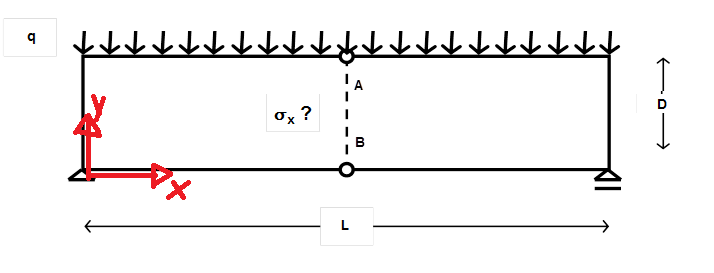EDIT: correction of your boundary conditions
Hey Gonza_! In your code, you wanted to treat the mechanical problem as follows.
You only had a slight syntax error in your boundary conditions
(*Wrong*)
bcwrong = {
DirichletCondition[v[x, y] == 0, {x == 0, y == 0}]
, DirichletCondition[u[x, y] == 0, {x == 0, y == 0}]
, DirichletCondition[v[x, y] == 0, {x == L, y == 0}]
};
(*Correct*)
bccorrect = {
DirichletCondition[{u[x, y] == 0, v[x, y] == 0}, x == 0 && y == 0]
, DirichletCondition[v[x, y] == 0, x == L && y == 0]
};
The difference is that the bcwrong impose a vanishing displacement field at every point with x==0 and at every point with y==0. The correct syntax is given in bccorrect. Working code:
Needs["NDSolve`FEM`"];
(*Geometry*)
L = 2;
h1 = 1/2;
Reg1 = Rectangle[{0, 0}, {L, h1}];
Mesh1 = ToElementMesh[Reg1, MeshQualityGoal -> 0];
(*Forces*)
q = 6000;
(*Material properties*)
Propiedades = {Y -> 205940000000, \[Nu] -> 30/100};
(*2D Hooke's law*)
hl = {
\[Sigma]x[x, y] ==
Y/(1 - \[Nu]^2) (D[u[x, y], x] + \[Nu] D[v[x, y], y])
, \[Sigma]y[x, y] ==
Y/(1 - \[Nu]^2) (D[v[x, y], y] + \[Nu] D[u[x, y], x])
, \[Sigma]xy[x,
y] == (Y*\[Nu])/(1 - \[Nu]^2) (D[u[x, y], x] + D[v[x, y], y])
};
(*Equations*)
PS = {Inactive[
Div][{{0, -((Y \[Nu])/(1 - \[Nu]^2))}, {-((Y (1 - \[Nu]))/(2 (1 \
- \[Nu]^2))), 0}}.Inactive[Grad][v[x, y], {x, y}], {x, y}] +
Inactive[
Div][{{-(Y/(1 - \[Nu]^2)),
0}, {0, -((Y (1 - \[Nu]))/(2 (1 - \[Nu]^2)))}}.Inactive[Grad][
u[x, y], {x, y}], {x, y}],
Inactive[
Div][{{0, -((Y (1 - \[Nu]))/(2 (1 - \[Nu]^2)))}, {-((Y \
\[Nu])/(1 - \[Nu]^2)), 0}}.Inactive[Grad][u[x, y], {x, y}], {x, y}] +
Inactive[
Div][{{-((Y (1 - \[Nu]))/(2 (1 - \[Nu]^2))),
0}, {0, -(Y/(1 - \[Nu]^2))}}.Inactive[Grad][
v[x, y], {x, y}], {x, y}]};
(*BCs*)
(*Neumann*)
bcN = {0, NeumannValue[-q, y == h1]};
(*Wrong*)
bcwrong = {
DirichletCondition[v[x, y] == 0, {x == 0, y == 0}]
, DirichletCondition[u[x, y] == 0, {x == 0, y == 0}]
, DirichletCondition[v[x, y] == 0, {x == L, y == 0}]
};
(*Correct*)
bccorrect = {
DirichletCondition[{u[x, y] == 0, v[x, y] == 0}, x == 0 && y == 0]
, DirichletCondition[v[x, y] == 0, x == L && y == 0]
};
(*FEM-solution*)
{u1, v1, \[Sigma]x1, \[Sigma]y1, \[Tau]xy1} =
NDSolveValue[{PS == bcN, hl, bccorrect} /. Propiedades, {u,
v, \[Sigma]x, \[Sigma]y, \[Sigma]xy}
, Element[{x, y}, Mesh1]];
(*Deformation*)
DMesh1 = ElementMeshDeformation[Mesh1, {u1, v1},
"ScalingFactor" -> 6*10^4];
Show[{Mesh1[
"Wireframe"[
"ElementMeshDirective" -> Directive[EdgeForm[Gray], FaceForm[]]]],
DMesh1[
"Wireframe"[
"ElementMeshDirective" ->
Directive[EdgeForm[RGBColor[0, 0.3, 0.8]], FaceForm[]]]]},
ImageSize -> 300]
(*Normal stress at x=L/2 depending on y*)
Plot[\[Sigma]x1[L/2, y]/1000, {y, 0, h1}, Filling -> Axis,
AxesLabel -> {"h[m]",
"\!\(\*SubscriptBox[\(\[Sigma]\), \(x\)]\)[kPa]"},
ImageSize -> 400]
General 3D theory




